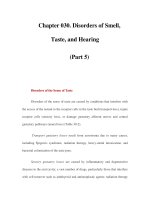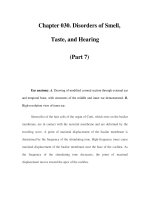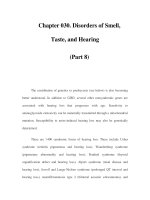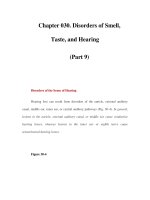Chapter 030. Disorders of Smell, Taste, and Hearing (Part 8) ppsx
Bạn đang xem bản rút gọn của tài liệu. Xem và tải ngay bản đầy đủ của tài liệu tại đây (14.31 KB, 5 trang )
Chapter 030. Disorders of Smell,
Taste, and Hearing
(Part 8)
The contribution of genetics to presbycusis (see below) is also becoming
better understood. In addition to GJB2, several other nonsyndromic genes are
associated with hearing loss that progresses with age. Sensitivity to
aminoglycoside ototoxicity can be maternally transmitted through a mitochondrial
mutation. Susceptibility to noise-induced hearing loss may also be genetically
determined.
There are >400 syndromic forms of hearing loss. These include Usher
syndrome (retinitis pigmentosa and hearing loss), Waardenburg syndrome
(pigmentary abnormality and hearing loss), Pendred syndrome (thyroid
organification defect and hearing loss), Alport syndrome (renal disease and
hearing loss), Jervell and Lange-Nielsen syndrome (prolonged QT interval and
hearing loss), neurofibromatosis type 2 (bilateral acoustic schwannoma), and
mitochondrial disorders [mitochondrial encephalopathy, lactic acidosis, and
stroke-like episodes (MELAS); myoclonic epilepsy and ragged red fibers
(MERRF); progressive external ophthalmoplegia (PEO)] (Table 30-4).
Table 30-4 Syndromic Hereditary Hearing Impairment Genes
Syndrome Gene Function
Alport syndrome COL4A3-
5
Cytoskeletal protein
BOR syndrome EYA1 Developmental gene
SIX1 Developmental gene
Jervell and Lange-
Nielsen syndrome
KVLQT1
KCNE1
Delayed rectifier K
+
channel
Delayed rectifier K
+
channel
Norrie disease Norrin Cell-cell interactions
Pendred syndrome SLC26A4 Chloride/iodide
transporter
Treacher Collins TCOF1 Nucleolar-cytoplasmic
transport
Usher syndrome MYO7A Cytoskeletal protein
USH1C Unknown
CDH23 Intercellular adherence
protein
PCDH15 Cell adhesion molecule
SANS Harmonin associated
protein
USH2A Cell adhesion molecule
VLGR1 G protein–coupled
receptor
USH3 Unknown
WS type I, III PAX3 Transcription factor
WS type II MITF Transcription factor
SLUG Transcription factor
WS type IV EDNRB Endothelin-B receptor
EDN3 Endothelin-B receptor
ligand
SOX10 Transcription factor
Note: BOR, branchio-oto-renal syndrome; WS, Waardenburg
syndrome.[newpage]









